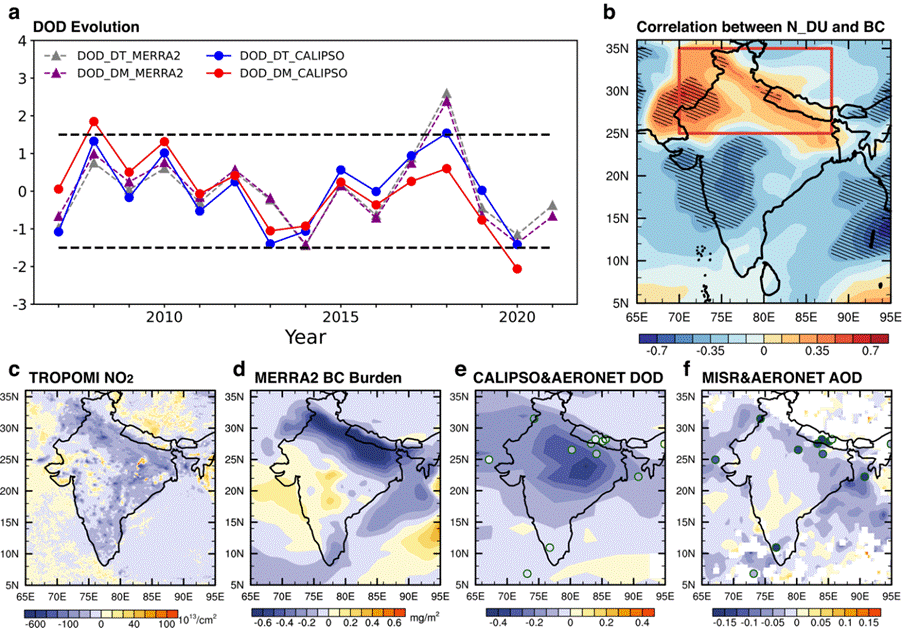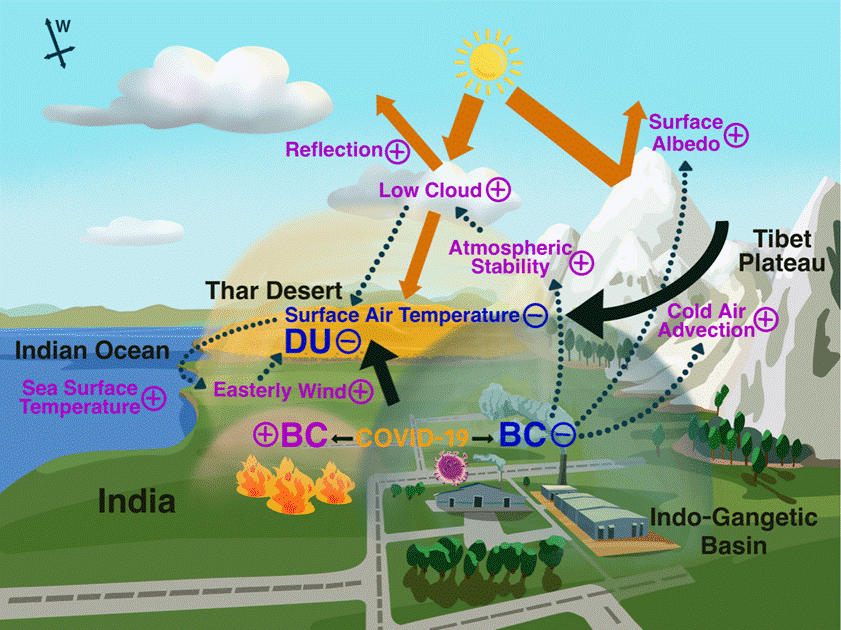Associate Professor Wang Yong’s Research Group of the Department of Earth System Science (DESS), Tsinghua University, in collaboration with Professor Liu Xiaohong’s Research Group of Texas A&M University in the United States, as well as other research groups at home and abroad, used the research methods of observation data, long-term Reanalysis data and climate model simulation to analyze how black carbon aerosols can regulate dust burdens and impact monsoon precipitation through their interaction with the climate, and presented a detailed mechanism analysis especially for the COVID-19 period in 2020.
India as a hotspot for air pollution has heavier black carbon aerosol loading than that of other countries in the world. Moreover, its special landform features and geographical location have also resulted in very serious dust aerosol pollution problems. As monsoon precipitation has a significant impact on local agricultural production and social activities in India, scholars pay special attention to the situation of Indian summer monsoon when exploring pollution and climate problems in the country. Previous studies have confirmed that India's black carbon and dust aerosol have an important impact on its climate in the premonsoon season and the monsoon season. In the premonsoon season, there are a lot of black carbon and dust aerosols in the atmosphere. One part of the black carbon in India comes from the emissions of industry, energy, transportation and other sectors, and the other part comes from the straw burning process. Dust aerosols mainly come from the local sand-raising process in the northwest Thar Desert and the long-distance transportation of sand-dust from remote deserts in Sahara and the Middle East, which is greatly influenced by climatic factors. Both types of aerosols have a certain absorption effect on radiation, regulate the energy budget of the atmosphere and the surface, and affect the snow in the vicinity of Tibetan Plateau and Himalayas through sedimentation. Previous studies tended to focus on the climate effects of black carbon and dust in India, while ignoring possible synergistic changes between them through climate effects, thus obstructing the understanding of pollution control in India. Therefore, it is still unclear whether the black carbon produced by anthropogenic emissions can regulate the natural dust loading in this area through its interactions with climate.
Addressing the above problems, the research group designed a research route of anthropogenic emission of black carbon--climate response--dust change. Based on the long-term Reanalysis data, the study revealed for the first time that dust in the premonsoon season (April-May) of India was positively correlated with black carbon in northern India, but negatively correlated with black carbon in southern India (Figure 1b). According to the above correlation, the research team also found that the black carbon aerosol configuration in India in the premonsoon season of 2020 (April-May) (Figure 1d) just corresponded to the record low dust aerosol loading in the same period (Figures 1a&e).

Fig. 1 Pollution in the premonsoon season(April-May).

Fig. 2 Mechanism of black carbon-climate interactions regulating dust loading.
The research team further used the observation, Reanalysis data and the earth system model CESM2 simulation to make a targeted mechanism analysis of the pollution emission changes and their climate response during the COVID-19 outbreak in 2020 (April-May) (Fig. 2). Due to the lockdown policy, the black carbon emitted by industries, energy, transportation and other departments and straw burning on large farms in northern India was greatly reduced (Fig. 1d), thus greatly reducing the atmospheric shortwave heating rate, increasing the surface albedo of the Tibetan Plateau, lowering the atmospheric temperature in northern India and stimulating downdraft. In addition, in the south of India, due to the shutdown of large farms in the northwest and the return of laborers to the south, the black carbon emitted by straw burning on individual farms in the south increased greatly, heating the local atmosphere. The warm air in the south was forced to rise by the cold air transported southward from the Tibetan Plateau in northern India, forming a large number of low clouds. The surface cooled, resulting in abnormal high pressure, which triggered the easterly wind anomaly. As a result, the weakened westerly wind reduced the dust transportation from the Middle East and Sahara Desert and the dust emission from the local Thar Desert in India, resulting in a record low of dust loading during the COVID-19 outbreak (Figures 1a&e). At the same time, the reduction of black carbon and dust in northern India further delayed the outbreak of Indian summer monsoon.
Based on the above results, a paper titled “Black Carbon-Climate Interactions Regulate Dust Burdens over India Revealed during COVID-19” was published online in Nature Communications on April 5, 2022.
Wei Linyi, Ph.D. student of DESS 2020 in Tsinghua University, and Dr. Lu Zheng of Texas A&M University in the United States are the co-first authors of the paper; Associate Professor Wang Yong of DESS, Tsinghua University and Professor Liu Xiaohong of Texas A&M University are the co-corresponding authors of the paper. Dr. Wang Weiyi and Wu Chenglai from the Institute of Atmospheric Physics (IAP), Chinese Academy of Sciences, Dr. Zhao Xi from Texas A&M University, Dr. Stefan Rahimi from UCLA, Dr. Xia Wenwen from DESS, Tsinghua University and Associate Professor Jiang Yiquan from Nanjing University are the co-authors of the paper. This research is supported by the Key Research and Development Projects of the Ministry of Science and Technology and the National Natural Science Foundation of China.
Full text: https://www.nature.com/articles/s41467-022-29468-1
Contributed by Wang Yong and Wei Linyi
Edited by Wang Jiayin
Reviewed by Zhang Qiang